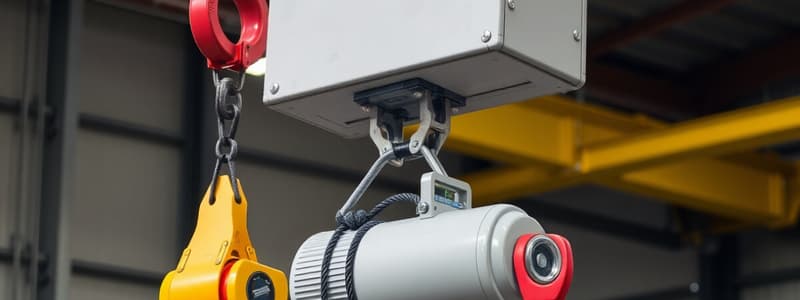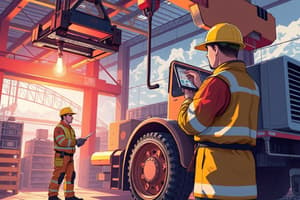Podcast
Questions and Answers
What is the primary purpose of verification in lifting equipment?
What is the primary purpose of verification in lifting equipment?
- To authorize the use of equipment in legal contexts
- To ensure compliance with safety and legal standards (correct)
- To provide a legal document for equipment ownership
- To replace the need for an inspection report
Which document signifies that lifting equipment is fit for continued use?
Which document signifies that lifting equipment is fit for continued use?
- Proof Load Test Report
- EC Declaration of Conformity
- Report of a Thorough Examination (correct)
- Manufacturers Certificate
What should manufacturers preferably provide along with a declaration of conformity?
What should manufacturers preferably provide along with a declaration of conformity?
- Safety, Health and Environmental Impact Assessment
- Advertising materials
- Verification details (correct)
- Legal ownership documents
How are test reports classified in terms of legal documentation?
How are test reports classified in terms of legal documentation?
What type of reports were previously referred to as 'birth certificates'?
What type of reports were previously referred to as 'birth certificates'?
Which of the following is NOT a method of verification for lifting equipment?
Which of the following is NOT a method of verification for lifting equipment?
What is the role of a Competent Person in the inspection of lifting equipment?
What is the role of a Competent Person in the inspection of lifting equipment?
Which of the following statements about the Report of a Thorough Examination is true?
Which of the following statements about the Report of a Thorough Examination is true?
What should a user declare when placing an order if risk assessment indicates a necessary reduction in SWL?
What should a user declare when placing an order if risk assessment indicates a necessary reduction in SWL?
What happens if a user does not declare the need for a reduced SWL when ordering equipment?
What happens if a user does not declare the need for a reduced SWL when ordering equipment?
Which conditions may require a reduction in the SWL?
Which conditions may require a reduction in the SWL?
In what circumstance is it essential for users to implement systems to prevent normal equipment use at full capacity?
In what circumstance is it essential for users to implement systems to prevent normal equipment use at full capacity?
What should be marked on equipment permanently fixed in place for specific duties?
What should be marked on equipment permanently fixed in place for specific duties?
If equipment is portable, what is a key recommendation for users?
If equipment is portable, what is a key recommendation for users?
Who is ultimately responsible for determining and marking the appropriate SWL if the user fails to declare information?
Who is ultimately responsible for determining and marking the appropriate SWL if the user fails to declare information?
Which factor is NOT a reason for reducing the working load limit to a lower SWL?
Which factor is NOT a reason for reducing the working load limit to a lower SWL?
What does SWL stand for in the context of lifting equipment?
What does SWL stand for in the context of lifting equipment?
Which of the following best describes the Working Load Limit (WLL)?
Which of the following best describes the Working Load Limit (WLL)?
Which statement about SWL and WLL is correct?
Which statement about SWL and WLL is correct?
Is a proof load test a component of a thorough examination for lifting accessories?
Is a proof load test a component of a thorough examination for lifting accessories?
What does the term ‘rated capacity’ refer to in lifting equipment?
What does the term ‘rated capacity’ refer to in lifting equipment?
What might the acronym SWL denote in regions that do not use the word ‘safe’?
What might the acronym SWL denote in regions that do not use the word ‘safe’?
What is often a source of confusion regarding lifting terms?
What is often a source of confusion regarding lifting terms?
What does the maximum safe working load represent?
What does the maximum safe working load represent?
What does the net result of risk account for?
What does the net result of risk account for?
What is the primary purpose of a risk assessment in the workplace?
What is the primary purpose of a risk assessment in the workplace?
Which of the following best describes a workplace's moral duty regarding risk?
Which of the following best describes a workplace's moral duty regarding risk?
In a scenario where most equipment requires a reduced working load, what should be done?
In a scenario where most equipment requires a reduced working load, what should be done?
What factors contribute to accidents or ill health in the workplace?
What factors contribute to accidents or ill health in the workplace?
What is the formula for determining the level of risk?
What is the formula for determining the level of risk?
Which statement correctly reflects the role of employers regarding workplace safety?
Which statement correctly reflects the role of employers regarding workplace safety?
How can a workplace's risk reduction efforts be quantified?
How can a workplace's risk reduction efforts be quantified?
What happens to iron from the blast furnace to make it suitable for lifting equipment?
What happens to iron from the blast furnace to make it suitable for lifting equipment?
What are non-ferrous metals known for?
What are non-ferrous metals known for?
What is the primary purpose of blending pure metals?
What is the primary purpose of blending pure metals?
What materials are typically used in the production of low carbon steel?
What materials are typically used in the production of low carbon steel?
What byproducts are produced when removing carbon from iron in the blast furnace?
What byproducts are produced when removing carbon from iron in the blast furnace?
What characteristic of pure iron limits its use in lifting equipment?
What characteristic of pure iron limits its use in lifting equipment?
What is an alloy?
What is an alloy?
Why is it necessary to process metal ores?
Why is it necessary to process metal ores?
What is the primary characteristic that differentiates higher tensile steel from mild steel?
What is the primary characteristic that differentiates higher tensile steel from mild steel?
Which of the following is used in the manufacture of lifting gear?
Which of the following is used in the manufacture of lifting gear?
What is a disadvantage of alloy steels compared to carbon steels?
What is a disadvantage of alloy steels compared to carbon steels?
Which element is commonly added to alloy steels to enhance their properties?
Which element is commonly added to alloy steels to enhance their properties?
What range of carbon percentage is typical for higher tensile steel?
What range of carbon percentage is typical for higher tensile steel?
In terms of hardness, how do alloys compare to pure metals?
In terms of hardness, how do alloys compare to pure metals?
Which of the following is an application of copper alloys?
Which of the following is an application of copper alloys?
What effect do elements like vanadium and chromium have when added to steel?
What effect do elements like vanadium and chromium have when added to steel?
Flashcards
Test Report
Test Report
A document detailing tests performed on equipment. Does not permit use unless part of a legal document.
EC Declaration of Conformity
EC Declaration of Conformity
Legal document proving new European equipment meets standards.
Manufacturers Certificate
Manufacturers Certificate
Legal document proving equipment meets standards. Alternative to EC Declaration
Report of Thorough Inspection
Report of Thorough Inspection
Signup and view all the flashcards
Verification
Verification
Signup and view all the flashcards
Competent Person
Competent Person
Signup and view all the flashcards
Report of Thorough Examination (or Inspection)
Report of Thorough Examination (or Inspection)
Signup and view all the flashcards
Lifting Equipment Records
Lifting Equipment Records
Signup and view all the flashcards
Safe Working Load (SWL)
Safe Working Load (SWL)
Signup and view all the flashcards
Working Load Limit (WLL)
Working Load Limit (WLL)
Signup and view all the flashcards
Rated capacity
Rated capacity
Signup and view all the flashcards
Proof load test
Proof load test
Signup and view all the flashcards
Thorough Examination
Thorough Examination
Signup and view all the flashcards
Lifting accessories
Lifting accessories
Signup and view all the flashcards
SWL markings
SWL markings
Signup and view all the flashcards
Reduced SWL
Reduced SWL
Signup and view all the flashcards
Hazardous duties
Hazardous duties
Signup and view all the flashcards
Risk assessment
Risk assessment
Signup and view all the flashcards
User's responsibility
User's responsibility
Signup and view all the flashcards
SWL declaration
SWL declaration
Signup and view all the flashcards
Fixed equipment
Fixed equipment
Signup and view all the flashcards
Portable equipment
Portable equipment
Signup and view all the flashcards
SWL
SWL
Signup and view all the flashcards
WLL
WLL
Signup and view all the flashcards
Risk
Risk
Signup and view all the flashcards
Inherent Danger
Inherent Danger
Signup and view all the flashcards
Moral Duty
Moral Duty
Signup and view all the flashcards
Safety and Health
Safety and Health
Signup and view all the flashcards
Reduced Working Load (RWL)
Reduced Working Load (RWL)
Signup and view all the flashcards
What are metals used for?
What are metals used for?
Signup and view all the flashcards
How are metals processed?
How are metals processed?
Signup and view all the flashcards
Ferrous Metals
Ferrous Metals
Signup and view all the flashcards
Non-ferrous Metals
Non-ferrous Metals
Signup and view all the flashcards
What is low carbon steel?
What is low carbon steel?
Signup and view all the flashcards
Why is pure iron not used in lifting equipment?
Why is pure iron not used in lifting equipment?
Signup and view all the flashcards
What is the process of making steel?
What is the process of making steel?
Signup and view all the flashcards
What is the purpose of removing carbon from molten iron?
What is the purpose of removing carbon from molten iron?
Signup and view all the flashcards
Mild Steel
Mild Steel
Signup and view all the flashcards
Higher Tensile Steel
Higher Tensile Steel
Signup and view all the flashcards
High Tensile Steel
High Tensile Steel
Signup and view all the flashcards
Alloy Steel
Alloy Steel
Signup and view all the flashcards
What are the disadvantages of alloys compared to carbon steel?
What are the disadvantages of alloys compared to carbon steel?
Signup and view all the flashcards
Copper
Copper
Signup and view all the flashcards
What is the effect of different atom sizes in alloys?
What is the effect of different atom sizes in alloys?
Signup and view all the flashcards
Study Notes
Industry Relevant Definitions
-
Minimum Breaking (or Failure) Load: The specified load (mass or force) below which the lifting equipment does not fail.
-
Multipurpose Equipment: Designed to a standard specification to lift various loads up to a marked safe working load (SWL). Not designed for one specific application.
-
Operative: A trained person using the lifting equipment.
-
Rated Capacity: The maximum gross load the lifting appliance can lift.
-
Proof or Test Load: Load (mass or force) applied by a Competent Person for testing. This load is marked on test certificates for lifting equipment verification.
-
Single Purpose Equipment: Lifting equipment designed for and dedicated to lifting a specific load in a specific manner or environment.
-
Report of Test: A report issued by a competent person detailing a test's specifics. It's not a legal document to use equipment, except when in support of other legal documents.
Verification
-
Verification: Procedures to ensure lifting equipment meets specifications, legal requirements, and is safe to operate. This includes proof load tests, sample break tests, calculations, and examinations.
-
Verification - New Equipment: Verification of new equipment methods depend on the standards being used. Assembled components verified to their own standards may not require further testing. On-site verification will depend on the competent person.
Report of a Thorough Examination
- Report of a Thorough Examination: A report issued by a Competent Person detailing the outcome of a thorough examination, highlighting defects or confirming fitness for continued use.
- A test report may be included as an appendix.
- This report becomes part of the lifting equipment's records.
Safe (Specific application) Working Load (SWL)
- Safe Working Load (SWL): The maximum load a lifting equipment is assessed to lift, lower, or suspend under specific conditions. It's noted on the equipment and in statutory records.
- In some regions, the term Safe Working Load is not used but the requirements remain the same.
- The SWL is typically equivalent to the working load limit, maximum safe working load, or the rated capacity, unless conditions require a lower SWL.
Working Load Limit (WLL)
- Working Load Limit (WLL): The maximum mass allowed by lifting equipment for lifting, lowering, and suspending.
- WLL is sometimes referred to as maximum SWL in some documents.
- WLL is more commonly used for lifting attachments, while rated capacity is used more widely for lifting appliances.
Controlling Risks
- The 3 primary reasons for risk assessment: Human harm, Legal effects, and Economic effects.
- Hazard: Something with the potential to cause harm.
- Danger: A liability of exposure to harm.
Probability & Severity
- Probability: The likelihood of a hazard occurring.
- Severity: The potential harm if the hazard occurs.
- Risk: Combined likelihood and severity.
Risk Assessment Methodology
-
Step 1: Hazard Identification
-
Step 2: Identify People at Risk
-
Step 3: Evaluate Risks and decide precautions
-
Step 4: Record Findings and Implement Them,
-
Step 5: Review Findings
-
Hierarchy of Control: Eliminate, Reduce, Isolate, Control, and PPE
-
Materials: Lifting equipment is typically made of Metals, Polymers, and Natural Products.
-
Steel Grades: Steel grades have breaking strengths (e.g., Grade 4 is 400N/mm2) in lifting equipment.
-
Strain Age Embrittlement: The steel becoming brittle from overstraining followed by resting in warm conditions.
Studying That Suits You
Use AI to generate personalized quizzes and flashcards to suit your learning preferences.




